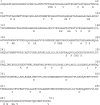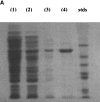Cloning, overexpression, and characterization of a bacterial Ca2+-dependent phospholipase D
- PMID: 12441393
- PMCID: PMC2373738
- DOI: 10.1110/ps.0225302
Cloning, overexpression, and characterization of a bacterial Ca2+-dependent phospholipase D
Abstract
Phospholipase D (PLD), an important enzyme involved in signal transduction in mammals, is also secreted by many microorganisms. A highly conserved HKD motif has been identified in most PLD homologs in the PLD superfamily. However, the Ca(2+)-dependent PLD from Streptomyces chromofuscus exhibits little homology to other PLDs. We have cloned (using DNA isolated from the ATCC type strain), overexpressed in Escherichia coli (two expression systems, pET-23a(+) and pTYB11), and purified the S. chromofuscus PLD. Based on attempts at sequence alignment with other known Ca(2+)-independent PLD enzymes from Streptomyces species, we mutated five histidine residues (His72, His171, His187, His200, His226) that could be part of variants of an HKD motif. Only H187A and H200A showed dramatically reduced activity. However, mutation of these histidine residues to alanine also significantly altered the secondary structure of PLD. Asparagine replacements at these positions yielded enzymes with structure and activity similar to the recombinant wild-type PLD. The extent of phosphatidic acid (PA) activation of PC hydrolysis by the recombinant PLD enzymes differed in magnitude from PLD purified from S. chromofuscus culture medium (a 2-fold activation rather than 4-5-fold). One of the His mutants, H226A, showed a 12-fold enhancement by PA, suggesting this residue is involved in the kinetic activation. Another notable difference of this bacterial PLD from others is that it has a single cysteine (Cys123); other Streptomyces Ca(2+)-independent PLDs have eight Cys involved in intramolecular disulfide bonds. Both C123A and C123S, with secondary structure and stability similar to recombinant wild-type PLD, exhibited specific activity reduced by 10(-5) and 10(-4). The Cys mutants still bound Ca(2+), so that it is likely that this residue is part of the active site of the Ca(2+)-dependent PLD. This would suggest that S. chromofuscus PLD is a member of a new class of PLD enzymes.
Figures






Similar articles
-
Expression and characterization of a heterodimer of Streptomyces chromofuscus phospholipase D.Biochim Biophys Acta. 2004 Dec 1;1703(1):43-51. doi: 10.1016/j.bbapap.2004.09.014. Biochim Biophys Acta. 2004. PMID: 15588701
-
Purification, biochemical characterization, and cloning of phospholipase D from Streptomyces racemochromogenes strain 10-3.Protein J. 2010 Nov;29(8):598-608. doi: 10.1007/s10930-010-9292-y. Protein J. 2010. PMID: 21082226
-
Study on thermostability of phospholipase D from Streptomyces sp.Biochim Biophys Acta. 2002 Jul 29;1598(1-2):156-64. doi: 10.1016/s0167-4838(02)00363-1. Biochim Biophys Acta. 2002. PMID: 12147356
-
Phospholipase D mechanism using Streptomyces PLD.Biochim Biophys Acta. 2009 Sep;1791(9):962-9. doi: 10.1016/j.bbalip.2009.01.020. Epub 2009 Feb 4. Biochim Biophys Acta. 2009. PMID: 19416643 Review.
-
Phospholipase D structure and regulation.Chem Phys Lipids. 1999 Apr;98(1-2):127-40. doi: 10.1016/s0009-3084(99)00025-0. Chem Phys Lipids. 1999. PMID: 10358935 Review.
Cited by
-
Expression, purification, and characterization of phospholipase B1 from Candida albicans in Escherichia coli.3 Biotech. 2020 Dec;10(12):538. doi: 10.1007/s13205-020-02515-8. Epub 2020 Nov 17. 3 Biotech. 2020. PMID: 33224707 Free PMC article.
-
Redundancy of human ATG4 protease isoforms in autophagy and LC3/GABARAP processing revealed in cells.Autophagy. 2019 Jun;15(6):976-997. doi: 10.1080/15548627.2019.1569925. Epub 2019 Feb 1. Autophagy. 2019. PMID: 30661429 Free PMC article.
-
Phosphohydrolase and transphosphatidylation reactions of two Streptomyces phospholipase D enzymes: covalent versus noncovalent catalysis.Protein Sci. 2003 Sep;12(9):2087-98. doi: 10.1110/ps.03192503. Protein Sci. 2003. PMID: 12931007 Free PMC article.
-
Asymmetric in vitro synthesis of diastereomeric phosphatidylglycerols from phosphatidylcholine and glycerol by bacterial phospholipase D.Lipids. 2004 Oct;39(10):1013-8. doi: 10.1007/s11745-004-1324-1. Lipids. 2004. PMID: 15691024
-
Molecular cloning, heterologous expression, and enzymatic characterization of lysoplasmalogen-specific phospholipase D from Thermocrispum sp.FEBS Open Bio. 2016 Oct 17;6(11):1113-1130. doi: 10.1002/2211-5463.12131. eCollection 2016 Nov. FEBS Open Bio. 2016. PMID: 27833852 Free PMC article.
References
-
- Andrade, M.A., Chacon, P., Merelo, J.J., and Moran, F. 1993. Evaluation of secondary structure of proteins from UV circular dichroism spectra using an unsupervised learning neural network. Protein Eng. 6 383–390. - PubMed
-
- Bohm, G., Muhr, R., and Jaenicke, R. 1992. Quantitative analysis of protein far UV circular dichroism spectra by neural networks. Protein Eng. 5 191–195. - PubMed
-
- Braman, J., Papworth, C., and Greener, A. 1996. Site-directed mutagenesis using double-stranded plasmid DNA templates. Methods Mol. Biol. 57 31–44. - PubMed
-
- Eible, H. and Kovatchev, S. 1981. Preparation of phospholipids and their analogues by phospholipase D. Methods Enzymol. 72 632–639. - PubMed
Publication types
MeSH terms
Substances
Grants and funding
LinkOut - more resources
Full Text Sources
Molecular Biology Databases
Miscellaneous

